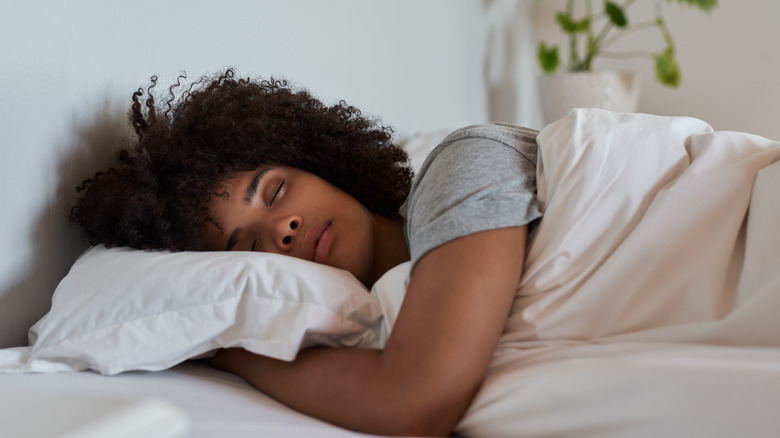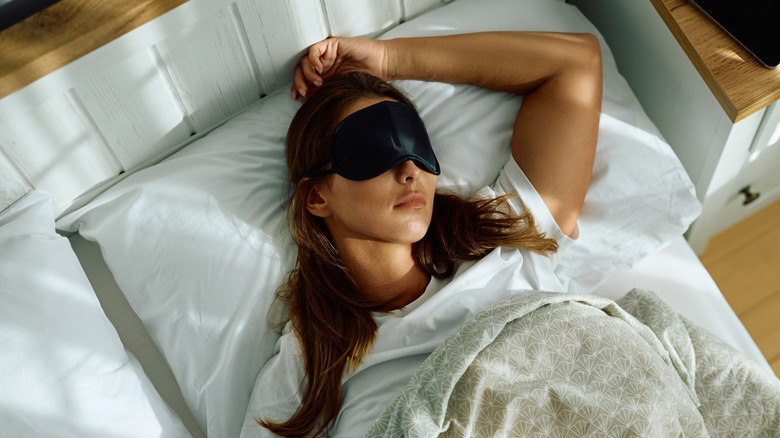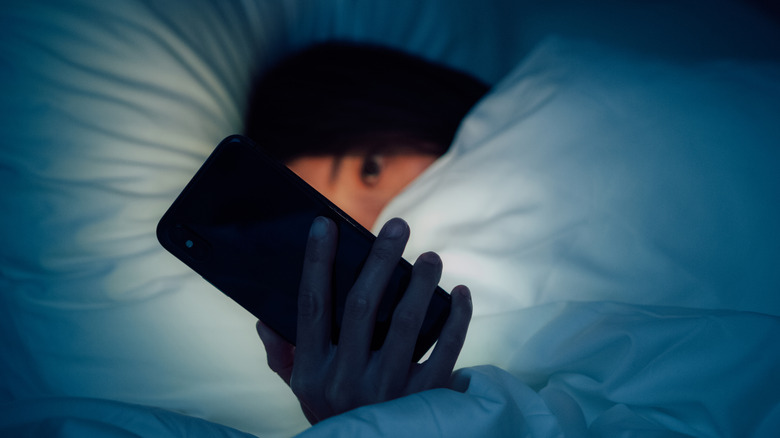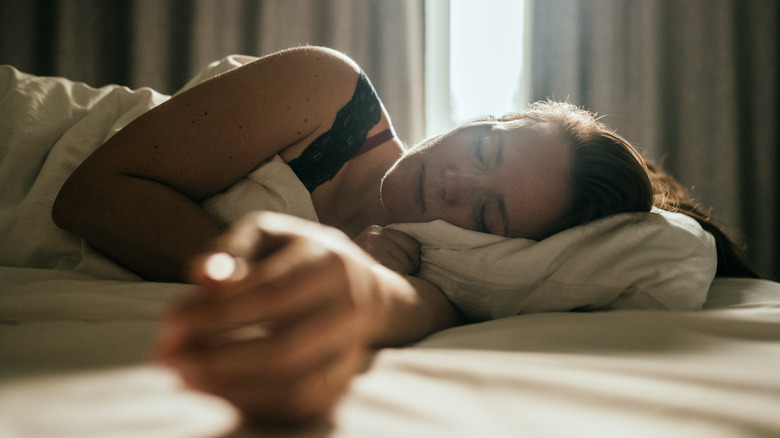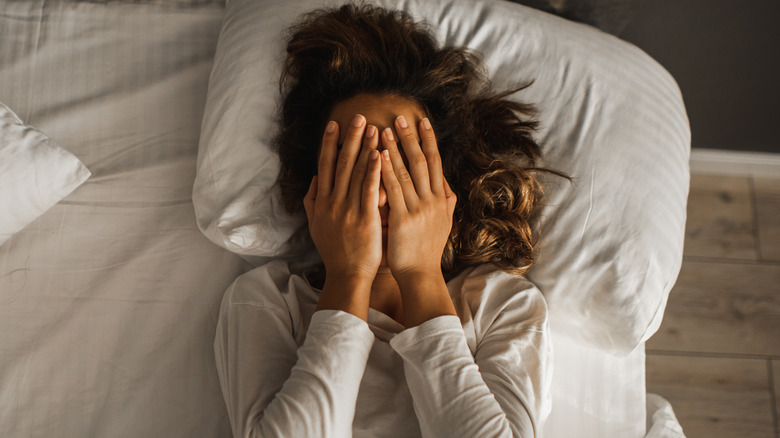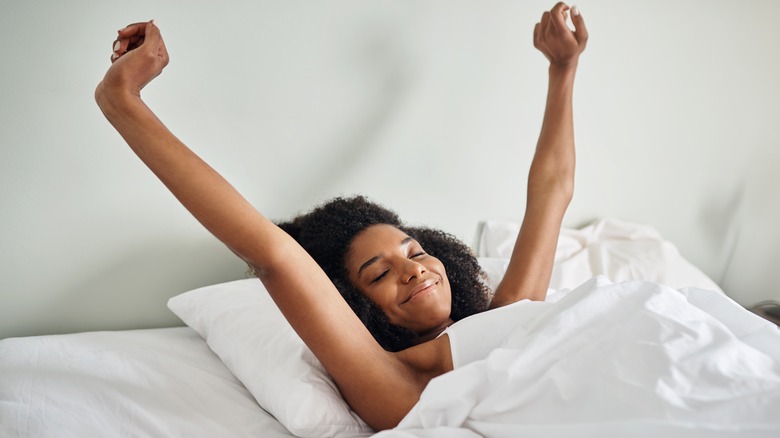What Is Sleepmaxxing — And Should You Be Trying It? The Benefits & Drawbacks, Explained
Sleepmaxxing is a viral trend that combines products and strategies to achieve the best sleep one possibly can. The goal is to maximize the quality and quantity of sleep through a myriad of hacks to optimize sleep efficiency. The term is all over social media, with content creators uploading videos that are pitched as sleepmaxxing guides, and inside scoops on which hacks work and which don't. The tips and advice come in such abundance that it would be a full-time job incorporating them into one's routine. TikTokers suggest different apps to track sleep cycles and devices to monitor one's sleep; there are the more obvious tidbits of advice, like limiting caffeine intake before bed and avoiding blue lights, like those emitted from electronics. Stimulating habits in general should be avoided. There are supplement suggestions, like magnesium and melatonin. Then there are the pre-sleep suggestions, like meditating before hitting the sack, eating a kiwi, and turning down the bedroom temperature.
Sleepmaxxing gurus also advise other habits, like mouth taping, which is all the rage but comes with a few risks. They suggest wearing an eye mask, and purchasing a white noise machine and a weighted blanket. There's a lot to take in when it comes to sleepmaxxing, and to understand the benefits and drawbacks of the trend, Women spoke with Dr. Raj Dasgupta, Chief Medical Advisor for Sleepopolis, to get a richer understanding of this viral wellness trend.
How much sleep do women need?
When it comes to sleepmaxxing, we want to know how women's physiological needs fit into the trend. Women and people assigned female at birth actually have different sleep needs than men do, particularly when it comes to hormonal shifts that come from menstrual cycles, pregnancy, and menopause. During these phases, more sleep might be needed. On average, women typically need between seven and nine hours of sleep every night. However, during periods, pregnancy, and menopause, women are much more likely to experience insomnia and sleep interruptions, so it's important to pay attention to fatigue levels and spend more time in bed as needed, even if it exceeds the average seven to nine hours that one would usually need.
Even outside of these hormonal phases, women tend to struggle with sleep more than men do. Women are more prone to insomnia, sleep issues, and in cases of child care and family needs, are more likely to be woken up than their male counterparts. With this in mind, the philosophy of sleepmaxxing has its benefits. The fact that the trend draws attention to the importance of sleep and prioritizes it is positive. There are no benefits to being a martyr and going without sleep when feeling fatigued, and it's not selfish to experiment with various hacks to see what can improve the quality of one's sleep.
Look at the quality of your sleep
One of the benefits of sleepmaxxing is that it encourages people to look at the quality of their sleep, not just the number of hours spent in bed. Several factors can impact sleep quality, and there are tell-tale signs when your quality of sleep has been compromised. "A lot of things can affect how well you sleep — stress, inconsistent bedtimes, too much screen time at night, caffeine too late in the day, or even the temperature of your room," Dr. Raj Dasgupta tells Women. These are all factors that sleepmaxxing gurus talk about and urge others to mitigate to have an optimum night's sleep. There can be all sorts of things that compromise the quality of one's sleep. Even learning how to share one's bed with a new partner can come with some adjustments so that both parties can have a good night's rest.
Dr. Dasgupta relays that there are several signs that one's sleep quality is suffering "If you're waking up feeling groggy, tossing and turning a lot, or relying on caffeine to get through the day, those are signs your sleep quality might not be great," he explains. If this is the case, it might be worth changing a few things about your sleep habits to see what can lead to a more restful, rejuvenating night.
Some facets of sleepmaxxing are good — but don't go overboard
We wanted to know if sleepmaxxing was worth trying. Naturally, everyone wants a better night's sleep, but sleepmaxxing can come with a long list of requirements, as well as several gadgets. Dr. Raj Dasgupta had a balanced approach to the trend, and there are a few things, in his opinion, about sleepmaxxing that are positive. "Some of the ideas behind sleepmaxxing — like sticking to a schedule and creating a good sleep environment — are definitely helpful," Dr. Dasgupta tells Women. These elements, what many refer to as sleep hygiene, predate the sleepmaxxing trend and have long been lauded as effective ways to have consistently healthy sleep. Picking a regular sleep schedule, and sticking to it — even on weekends — is a tried and true method for getting quality sleep. Creating a good sleep environment, like putting away electronics 30 to 60 minutes before bed, blocking out light, and lowering the temperature in one's bedroom, are also beneficial.
However, Dr. Dasgupta warns of the excessive elements of sleepmaxxing. "But going overboard with tracking every detail or spending a fortune on sleep gadgets can actually make you more anxious about sleep, which defeats the purpose," he explains. "The basics usually work just fine." If trying to complete every hack in the sleepmaxxing world makes overwhelms you, it'll backfire. Pick a few elements that help, particularly those that create feelings of peace and tranquility, and stick to those.
The potential drawbacks of sleepmaxxing
While there are perks to sleepmaxxing, like setting a routine sleep schedule and acknowledging the importance of sleep for physical and mental health, there are some drawbacks to the trend. "The biggest issue is that it can make people obsess over getting 'perfect' sleep, which can backfire," Dr. Raj Dasgupta tells Women. If people get too invested in following every single hack, it can lead to an unhealthy fixation on sleep. And nothing makes it harder to sleep than stress and anxiety. Furthermore, if someone has a bad night's sleep — which happens from time to time, no matter how perfectly one sleepmaxxes — it can lead to feelings of failure or additional stress. This trend establishes a goal of being the perfect sleepmaxxer, when the actual point of doing it is to facilitate consistent, healthy sleep.
On top of this, Dr. Dasgupta notes that some of the sleepmaxxing trends are just social media folklore. "Not all sleep hacks are backed by science, and some can be pricey without real benefits," he warns. For instance, eating a kiwi is great, but it's not a guarantee that its sleep effects will work on everyone. There should be no pressure to follow every single tip and trick.
The best practices for a good night's sleep
For those who want to improve sleep quality, there are a few things worth doing. Dr. Raj Dasgupta recommends, "Keep it simple: go to bed and wake up at the same time every day (yes, even on weekends), avoid screens before bed, and make sure your room is dark and cool [...] A solid bedtime routine — reading, stretching, or anything relaxing — can also help signal to your body that it's time to wind down." These habitual practices make sleep come more easily, and provide a greater restorative quality. If there are other hacks from the sleepmaxxing trend that seem beneficial, give them a try. If you wake up throughout the night needing to use the bathroom, consider cutting down on liquids two hours before bed, and see if that works. The point is that these simple tips are customizable to you and your sleep needs.
"If sleep is still a struggle, it might be worth looking into stress levels, diet, or possible underlying health issues," Dr. Dasgupta adds, noting that there could be other reasons for disrupted sleep. If this is the case, it could be worth discussing sleep concerns with your doctor or therapist, because everyone deserves a restful night in bed.
